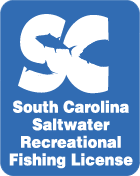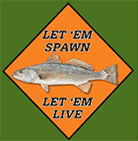Spotted Seatrout Health Assessment
For over 20 years, the South Carolina Department of Natural Resources’ (SCDNR) Marine Resources Division has been involved in an experimental stock enhancement program designed to answer questions about estuarine ecology and evaluate the effectiveness of stocking marine fish in estuarine environments. The guiding principle of this program is the “responsible approach to marine stock enhancement,” which means, among other things, that we take great pride in releasing fish that are healthy, disease free, and not harmful to the existing wild population. Currently, SCDNR is developing an experimental stock enhancement program for spotted seatrout, a species of great recreational importance to the state.

The first year of development for the spotted seatrout stock enhancement program involved developing protocols for capturing and spawning broodstock, nursery pond management, and harvest techniques. Assessing the health of animals harvested from ponds, by observing them in tank systems post-harvest, was an essential step in assuring that fish released in the wild would be healthy and have a good chance for survival. While other fish that we work with, including red drum and striped bass, are hardy and survive handling well, spotted seatrout have proven to be more difficult. Their smaller and thinner scales lend themselves to excess abrasion when they are netted during harvest and these abrasions can lead to secondary infections and increased mortality. Current research aims to reexamine harvest techniques and determine safe handling procedures to minimize damage to spotted seatrout. In particular, we are developing protocols for using fluorescein dye (fig. 1) as a tool for fish health assessment.
Fluorescein binds with damaged tissue and fluoresces under ultra-violet (UV) light, allowing for the detection and assessment of abrasion even when noticeable signs of damage are absent. In fact, fluorescein is the same chemical the eye doctor puts in your eye to determine if you have scratched the lens. It is fast-acting and sensitive, clearly showing damage under UV light, effective at low concentrations, and has been shown to have no adverse affects on fish or the environment. Our current research is using fluorescein dye to quantify the amount of abrasion caused by the use of several net types in spotted seatrout during harvest and transport. We are also interested in investigating the link between the amount of skin damage on the fish and mortality in order to develop protocols that will result in increased survival of hatchery-produced spotted seatrout.
To assess the effects of nets on health of spotted seatrout, juvenile (1-2 inches) spotted sea trout were harvested from saltwater ponds at the Waddell Mariculture Center using three net types; 1/64” knotless nylon, 3/16” knotless nylon and 3/16” rubber-coated knotless nylon. Four subsamples were taken from fish harvested with each type of net and exposed to the fluorescein dye for a period of 6 minutes. The exposed fish were then placed in a flow-through aquarium to allow any unabsorbed dye to be washed away and then euthanized for examination. Each fish was then illuminated with a handheld shortwave UV light and photographed with a high-resolution camera. The fish not chosen for fluorescein exposure were stocked into 6-foot recirculating tank systems (two tanks for each type of net) and observed over a 7-day period to determine rates of mortality. The following week, the entire experiment was repeated with a group of spotted seatrout harvested from a different pond. Methods were similar to the above, but the smallest (1/64”) mesh size was determined to be unfeasible for harvest and eliminated. Three tanks were used for each of the two net types.
Each image taken during the first two experiments was analyzed using ImageJ computer software. The amount of abrasion, determined by the presence of fluorescence, was quantified by the program and fluorescent areas unable to be auto-analyzed were measured manually using the image software. Measurements were recorded and total percent abrasion for each fish was calculated.
During image evaluation we determined that 1-2 inch spotted seatrout show a large degree of fluorescence around the jaw and gills and around the underside of the fish (fig. 2).

We also noticed that when pressure was applied to fluorescent abdomens that fluorescein leaked out. We found that these small fish gulped down the dye during treatment and were simply expelling the liquid. Through careful evaluation under the microscope we found that fluorescence around the jaw and gills were due to real damage while fluorescence around the gut was an artifact of ingestion of the fluorescein liquid. Both net types damaged the jaw and gill plate of spotted seatrout, with 38% of all exposed fish showing fluorescence in these areas. Damage to these regions likely resulted from small seatrout “gilling” themselves in the mesh of the net. The rubber-coated nylon net resulted in greater abrasion than its knotless nylon counterpart, but significant differences in survival were not observed in these preliminary trials.
Future research will further refine the above study and introduce additional mesh sizes and materials for consideration. Additionally, fluorescein dye has a high potential for assessing the damage caused to wild fish through scientific sampling programs or commercial or recreational fishing activities. While the appropriate net type for spotted seatrout harvest cannot be conclusively determined through this preliminary research, this study provides a foundation for development of fluorescein as a useful tool in fish health management.



